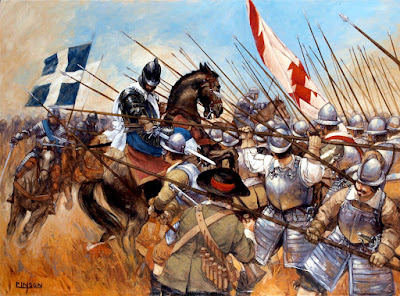At Rocroi, 22-year old Louis Duc d'Enghien defeated the Spanish Army of Flanders led by experienced General Francisco de Melo and Maestre de Campo Paul-Bernard de Fontaines.
This decisive victory took place only five days after the accession of
young Louis XIV, late in the Thirty Years' War. It is considered the
turning point of the perceived invincibility of the Spanish tercio.
The
Habsburgs had 27,000 men, the French 23,000. The French army attacked,
but the infantry in the center were bested by the Spanish. The cavalry
on the French left, advancing against Enghien's orders, was also thrown
back. But the cavalry on the French right, under the command of Jean de
Gassion, routed the Spanish cavalry opposite.
Enghien
was able to follow this up by attacking the exposed left flank of the
Spanish infantry. Spanish cavalry made a successful counter-attack to
drive off the French cavalry, but were checked by the advance of the
French reserve.
Enghien
now carried out a huge cavalry encirclement, sweeping behind the
Spanish army and smashing his way through to attack the rear of the
Spanish cavalry, which was still in combat with his reserves. The
Spanish horse was put to flight, leaving the Spanish infantry to carry
on the fight.
The
French were twice repulsed by the stubborn Spanish squares, so Enghien
arranged for his artillery and captured Spanish guns to blast them
apart. The German and Walloon tercios fled from the
battlefield, while the Spanish remained on the field with their
commander, repulsing four cavalry charges by the French and never
breaking formation, despite repeated heavy artillery bombardment.
Enghien then offered surrender conditions just like those obtained by a
besieged garrison in a fortress. Having agreed to those terms, the
remains of the two tercios left the field with deployed flags and
weapons. Enghien himself had conceived and directed the decisive
victory.
The total Spanish losses were about 7,000 dead, wounded, or captured. French losses were about 4,000.
The Battle given at Rocroi proved to be a resounding victory for the French Royal army under the Duc d’Enghien. Until then, the tercios were considered invincible. Combining a force of trained pikemen and the fire of the arquebusiers, the tercios were the tool of Spanish domination in Europe throughout the 16th and the first half of the 17th century.
To
defeat them, the impetuous Duke of Enghien compensated for his
numerical inferiority by his speed of maneuver and by making extensive
use of his cavalry, routing the opponent’s own mounted forces, before
falling back on the tercios’ rear and attacking them from all sides. The Army of Flanders lost most of its forces, including Maestre de Campo Paul-Bernard de Fontaine and 250 flags. This stunning victory against the renown Spanish tercios was unprecedented.
While Spain continued to use tercios,
other European nations moved away from them, and even Spain was
modifying them before they were eventually consigned to the memories of a
glorious time in Spain's past.
A majority of historians, including myself, consider that this is clearly the
beginning of the end of the Spanish predominance in Europe and of the
tercios: There is one more Bavarian-Imperial victory at Tuttingen in
November of the same year. At Montijo the next year the Portuguese
defeated the Spaniards. At Nördlingen in 1645 the French defeated the
Imperials. At Lens in 1648 once again Condé defeated the Spaniards. In
1654 at Arras this time it was Turenne who defeated the Spaniards. The
last Spanish victory against the French was at Valenciennes in 1656, but
3 years later at Les Dunes Turenne crushed the Spaniards and this
victory led to the Treaty of the Pyrenees. Thus, the only clear Spanish
victory after Rocroi was Valenciennes and the last one.






No comments:
Post a Comment